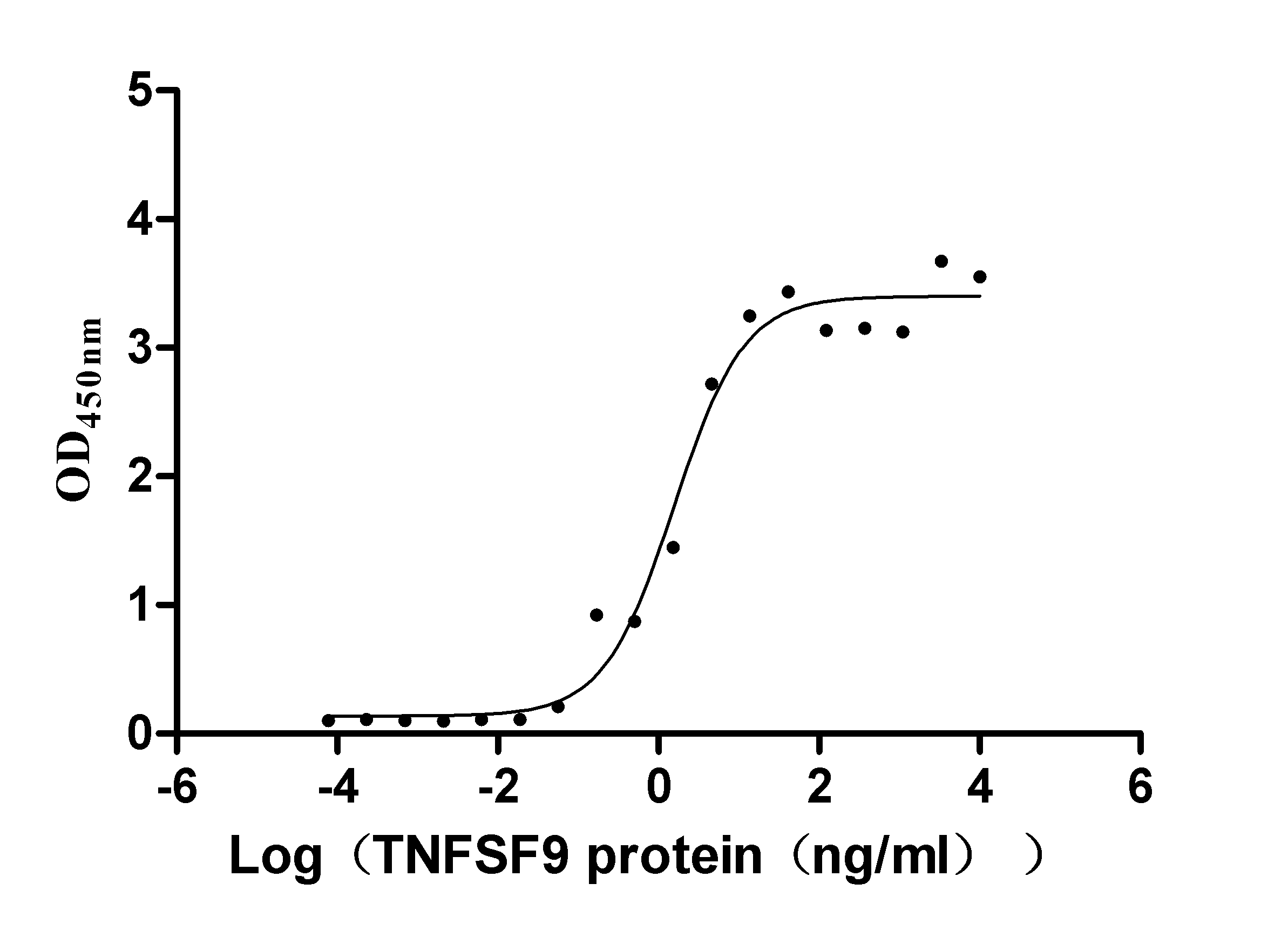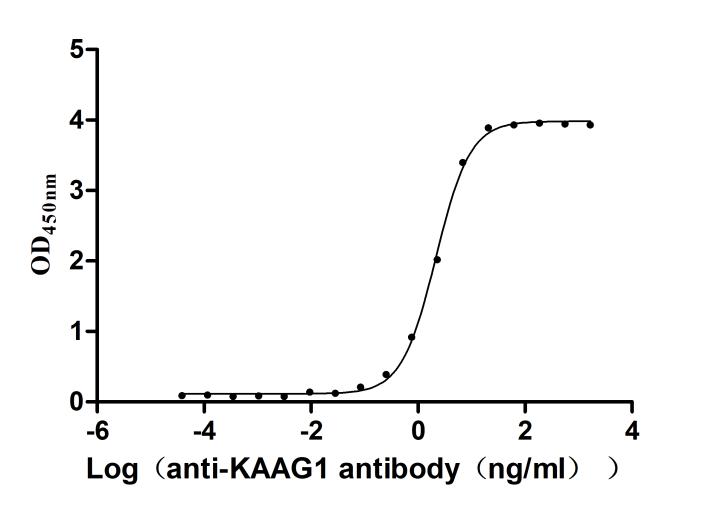Recombinant Rat Neuromedin-K receptor (Tacr3), partial
-
货号:CSB-YP023070RA1
-
规格:
-
来源:Yeast
-
其他:
-
货号:CSB-EP023070RA1
-
规格:
-
来源:E.coli
-
其他:
-
货号:CSB-EP023070RA1-B
-
规格:
-
来源:E.coli
-
共轭:Avi-tag Biotinylated
E. coli biotin ligase (BirA) is highly specific in covalently attaching biotin to the 15 amino acid AviTag peptide. This recombinant protein was biotinylated in vivo by AviTag-BirA technology, which method is BriA catalyzes amide linkage between the biotin and the specific lysine of the AviTag.
-
其他:
-
货号:CSB-BP023070RA1
-
规格:
-
来源:Baculovirus
-
其他:
-
货号:CSB-MP023070RA1
-
规格:
-
来源:Mammalian cell
-
其他:
产品详情
-
纯度:>85% (SDS-PAGE)
-
基因名:
-
Uniprot No.:
-
别名:Tacr3; Tac3r; Neuromedin-K receptor; NKR; NK-3 receptor; NK-3R; Neurokinin B receptor; Tachykinin receptor 3
-
种属:Rattus norvegicus (Rat)
-
蛋白长度:Partial
-
蛋白标签:Tag type will be determined during the manufacturing process.
The tag type will be determined during production process. If you have specified tag type, please tell us and we will develop the specified tag preferentially. -
产品提供形式:Lyophilized powder
Note: We will preferentially ship the format that we have in stock, however, if you have any special requirement for the format, please remark your requirement when placing the order, we will prepare according to your demand. -
复溶:We recommend that this vial be briefly centrifuged prior to opening to bring the contents to the bottom. Please reconstitute protein in deionized sterile water to a concentration of 0.1-1.0 mg/mL.We recommend to add 5-50% of glycerol (final concentration) and aliquot for long-term storage at -20℃/-80℃. Our default final concentration of glycerol is 50%. Customers could use it as reference.
-
储存条件:Store at -20°C/-80°C upon receipt, aliquoting is necessary for mutiple use. Avoid repeated freeze-thaw cycles.
-
保质期:The shelf life is related to many factors, storage state, buffer ingredients, storage temperature and the stability of the protein itself.
Generally, the shelf life of liquid form is 6 months at -20°C/-80°C. The shelf life of lyophilized form is 12 months at -20°C/-80°C. -
货期:Delivery time may differ from different purchasing way or location, please kindly consult your local distributors for specific delivery time.Note: All of our proteins are default shipped with normal blue ice packs, if you request to ship with dry ice, please communicate with us in advance and extra fees will be charged.
-
注意事项:Repeated freezing and thawing is not recommended. Store working aliquots at 4°C for up to one week.
-
Datasheet :Please contact us to get it.
相关产品
靶点详情
-
功能:This is a receptor for the tachykinin neuropeptide neuromedin-K (neurokinin B). It is associated with G proteins that activate a phosphatidylinositol-calcium second messenger system. The rank order of affinity of this receptor to tachykinins is: neuromedin-K > substance K > substance P.
-
基因功能参考文献:
- The different impacts of diverse long-term exercise intensities on the male pituitary-gonadal axis maybe relay by the various changes in hypothalamic Nkb and Pdyn gene expressions. PMID: 30207304
- Results give support to the involvement of NK3 receptors in the anxiogenic-like actions of SP6-11(C-terminal), where this metabolite seems to behave as an antagonist, in a way similar to SR142801. PMID: 26851555
- Median preoptic nucleus NK3R neurons facilitate cutaneous vasodilation, an important heat-dissipation effector. PMID: 25825817
- data suggest that endogenous NeuroKinin B-Neurokinin 3 Receptor signalling plays a role in controlling the timing of puberty. PMID: 24863620
- Data indicate that the suppression of the GnRH pulse generator by acute systemic stress equires hypothalamic NKB/neurokinin B (NKB) receptor (NK3R) signaling. PMID: 24708241
- evidence that the neurokinin3 receptors (NK3-R) and their influence on acetylcholine release may represent a crucial mechanism that underlies age-related deficits in learning and memory PMID: 23983264
- Activation of the NK3R appears to recruit multiple pathways, including acetylation, and possibly histone deactylases, histone methylases, or DNA methylases to affect chromatin structure and gene expression. PMID: 22985858
- data provide unique evidence that KNDy neurons promote cutaneous vasodilatation and participate in the E(2) modulation of body temperature PMID: 23150555
- Nkr3 peptide may exacerbate 6-OHDA toxicity in an in-vivo model, by modulation of N-methyl-D-aspartate receptor (Grin)1 subunit and c-Jun N-terminal kinase (JNK) pathway activities. PMID: 22762252
- Since NK3-R is widely distributed in the CNS, the presence of NK3-R in nuclei from multiple brain regions suggests that it may broadly influence CNS gene expression in a ligand-dependent manner. PMID: 21939739
- In response to hyperosmolarity, NK3R is transported to the nucleus of paraventricular hypothalamic neurons and associates with acetylated histone H3 and H4. PMID: 21697521
- Data suggest that NKB/NK3R signaling in kisspeptin+ neurons in the arcuate nucleus plays a pivotal role in control of GnRH/LH secretion. NKB and NK3R mRNAs are widely expressed in the central forebrain. PMID: 21045176
- In response to acute hyperosmotic challenge, NK3R associates with importin ss-1 which enables the nuclear transport of NK3R. PMID: 20709160
- heterologous and homologous desensitization of NK3-R-mediated contractility is dependent upon the duration of exposure to estrogen PMID: 12390879
- NK3 receptors had a distinct distribution in the caudal half of the solitary nucleus, suggesting a unique role in processing taste input from the posterior tongue. PMID: 15121234
- The NK3R receptor has a role in tanscription regulation in hypotension-induced tachykinin release in the supraoptic nucleus. PMID: 15537880
- These data suggest that NKB neurons could indirectly influence anterior pituitary function by inputs to arcuate neuroendocrine neurons, but through a receptor other than NK3R. PMID: 16025449
- NK(3) receptors are available in cytoplasmic reserve in dopaminergic neurons, but more immediately accessible at the plasmalemmal surface of non-dopaminergic dendrites in both the SN and VTA. PMID: 17197098
- Data provide evidence that neurokinin 3 receptors are involved in the control of the hyperlocomotor and nucleus accumbens dopamine response to cocaine, but not in cocaine-induced conditioned place preference. PMID: 17445241
- NK3R activation contributes significantly to the systemic release of both vasopressin and oxytocin in response to osmotic and hypotensive challenges. PMID: 17522129
- NK3R signaling in magnocellular neurons has a critical role for the release of VP and OT in response to hypotension. PMID: 18650316
收起更多
-
亚细胞定位:Cell membrane; Multi-pass membrane protein.
-
蛋白家族:G-protein coupled receptor 1 family
-
数据库链接:
KEGG: rno:24808
STRING: 10116.ENSRNOP00000012473
UniGene: Rn.9702




















